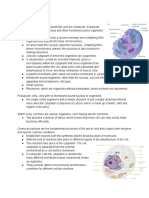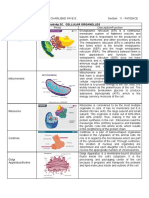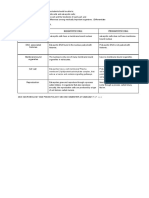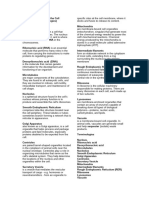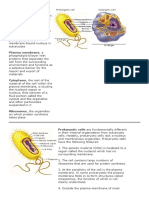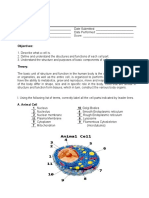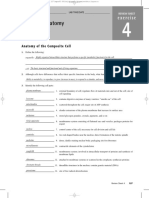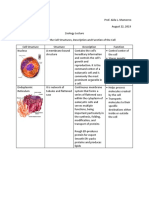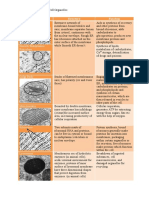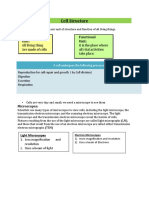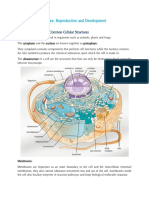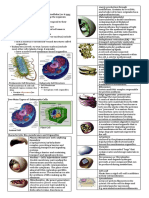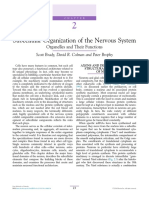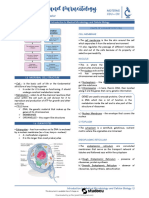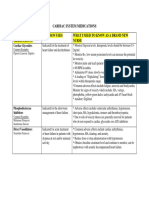Neve Cell
Neve Cell
Uploaded by
Aaron WallaceCopyright:
Available Formats
Neve Cell
Neve Cell
Uploaded by
Aaron WallaceCopyright
Available Formats
Share this document
Did you find this document useful?
Is this content inappropriate?
Copyright:
Available Formats
Neve Cell
Neve Cell
Uploaded by
Aaron WallaceCopyright:
Available Formats
Parts of the nerve cell and their function 06/11/02 15:09
Parts of the Nerve Cell and Their Functions
Silvia Helena Cardoso, PhD
[1. Cell body] [2.Neuronal membrane] [3.Dendrites] [4. Axon] [5. Nerve ending]
1. Cell body
The cell body (soma) is the factory of the neuron. It produces all the
proteins for the dendrites, axons and synaptic terminals and contains
specialized organelles such as the mitochondria, Golgi apparatus,
endoplasmic reticulum, secretory granules, ribosomes and
polysomes to provide energy and make the parts, as well as a
production line to assemble the parts into completed products.
Cytosol - Is the watery and salty fluid with a potassium-rich solution
inside the cell containing enzymes responsible for the metabolism of
the cell.
1. Nucleus - Derived from the Latin word for "nux", nut, the nucleus
is the archivist and the architect of the cell. As archivist it contains the
genes, consisting of DNA which contains the cell history, the basic
information to manufacture all the proteins characteristic of that cell.
As architect, it synthesizes RNA from DNA and ships it through its
pores to the cytoplasm for use in protein synthesis.
The.Nucleolus is an organelle within the nucleus which is involved
actively in ribosome synthesis and in the transfer of RNA to the
cytosol.
http://www.epub.org.br/cm/n07/fundamentos/neuron/parts_i.htm Page 1 sur 5
Parts of the nerve cell and their function 06/11/02 15:09
2. Golgi Apparatus - membrane-bound structure that plays a role in
packaging peptides and proteins (including neurotransmitters) into
vesicles.
3. Polyribosomes - there are several free ribosomes attached by a
thread. The thread is a single strand of mRNA (messenger RNA, a
molecule involved in the synthesis of proteins outside the nucleus).
The associated ribosomes work on it to make multiple copies of the
same protein.
4. Neuronal membrane (see next box)
5. Mitochondrium - this is the part of the cell responsible for the
supply of energy in the form of ATP (adenosine triphosphate).
Neurons need an enormous amount of energy. The brain is one of
the most metabolically active tissues in the body. In man, for
example, the brain uses 40 ml of oxygen per minute. Mitochondria
use oxygen and glucose to produce most of the cell's energy.
The brain consumes large amounts of ATP. The chemical energy
stored in ATP is used to fuel most of the biochemical reactions of the
neuron. For example, special proteins in the neuronal membrane use
the energy released by the breakdown of ATP into ADP to pump
certain substances across the membrane to establish concentration
differences between the inside of the neuron and the outside.
6. Rough Endoplasmic Reticulum and Smooth Endoplasmic
Reticulum (7) - A system of tubes for the transportation of materials
within the cytoplasm. It may have ribosomes (rough ER) or no
ribosomes (smooth ER). With ribosomes, the ER is important for
protein synthesis.
Nissl Bodies - Groups of ribosomes used for protein synthesis.
2. Neuronal Membrane
http://www.epub.org.br/cm/n07/fundamentos/neuron/parts_i.htm Page 2 sur 5
Parts of the nerve cell and their function 06/11/02 15:09
The neuronal membrane serves as
a barrier to enclose the cytoplasm
inside the neuron, and to exclude
certain substances that float in the
fluid that bathes the neuron.
The membrane with its mosaic of
proteins is responsible for many
important functions:
keeping certain ions and small
molecules out of the cell and
letting others in,
accumulating nutrients, and
rejecting harmful substances,
catalyzing enzymatic reactions,
establishing an electrical
potential inside the cell,
conducting an impulse
being sensitive to particular
neurotransmitters and
modulators .
The membrane is made of lipids and proteins - fats and chains of aminoacids. The basic
structure of this membrane is a bilayer or sandwich of phospholipids, organized in such a way
that the polar (charged) regions face outward and the non polar regions face inward.
The external face of the membrane contains the receptors, small specialized molecular regions
which provide a kind of "attachment port" for other external molecules, in a scheme analogous to
a a key and a keyhole. For each external molecule there is a corresponding receptor. Whenever
receptors become attached to a molecule, some alterations of the membrane and in the interior
of the cell ensue, such as the modification of permeability to some ions.
3. Dendrites
These structures branch out in treelike fashion and serve as the main
apparatus for receiving signals from other nerve cells. They function as an
"antennae" of the neuron and are covered by thousands of synapses. The
dendritic membrane under the synapse (the post-synaptic membrane) has
many specialized protein molecules called receptors that detect the
neurotransmitters in the synaptic cleft. A nerve cell can have many dendrites
which branch many times, their surface is irregular and covered in dendritic
spines which are where the synaptic input connections are made.
4. Axon
http://www.epub.org.br/cm/n07/fundamentos/neuron/parts_i.htm Page 3 sur 5
Parts of the nerve cell and their function 06/11/02 15:09
Usually a long process which often projects to distant regions of the
nervous system. The axon is the main conducting unit of the neuron,
capable of conveying electrical signals along distances that range
from as short as 0.1 mm to as long as 2 m. Many axon split into
several branches, thereby conveying information to different targets.
Many neurons do not have axons. In these so-called amacrine
neurons, all the neuronal processess are dendrites. Neurons with
very short axons are also found.
The axons of many neurons are wrapped in a myelin sheat, which is
Axon
composed of the membranes of intersticial cells and is wrapped
around the axons to form several concentric layers. The myelin
sheath is broken at various points by the nodes of Ranvier, so that in
cross section it looks like a string of sausages. The myelin protects
the axon, and prevents interference between axons as they pass
along in bundles, sometimes thousands at time.
The cells that wrap around peripheral nerve fibers - that is, nerve
fibers outside of the brain and spinal cord - are called Schwann cells
(because they were first described by Theodor Schwann). The cells
that wrap around axons within the central nervous system (brain and
spinal cord) are called oligodendrocytes. The axon, with its
surrounded sheath, is called a nerve fiber. Between each pair of
sucessive Schwann cells is a gap of a node of Ranvier.
The Axon Hillock
The axon hillock is where the axon is joined to the cell. It is from here
that the electrical firing known as an action potential usually occurs.
5. Nerve Ending (Presynaptic Terminals)
http://www.epub.org.br/cm/n07/fundamentos/neuron/parts_i.htm Page 4 sur 5
Parts of the nerve cell and their function 06/11/02 15:09
Synapses are the junctions formed with other nerve cells where the
presynaptic terminal of one cell comes into 'contact' with the postsynaptic
membrane of another. It is at these junctions that neurons are excited,
inhibited, or modulated. There are two types of synapse, electrical and
chemical.
Electrical synapses occur where the presynaptic terminal is in electrical
continuity with the postsynaptic. Ions and small molecules passing
through, thus connecting channels from one cell to the next, so that
electrical changes in one cell are transmitted almost instantaneously to the
next. Ions can generally flow both ways at these junctions i.e. they tend to
be bi-directional, although there are electrical junctions where the ions can
only flow one way, these are know as rectifying junctions. Rectifying
junctions are used to synchronise the firing of nerve cells.
Chemical synaptic junction is more complicated. The gap between the
post- and presynaptic terminals is larger, and the mode of transmission is
not electrical, but carried by neurotransmitters, neuroactive substances
released at the presynaptic side of the junction. There are two types of
chemical junctions. Type I is an excitatory synapse, generally found on
dendrites, type II is an inhibitory synapse, generally found on cell bodies.
Different substances are released at these two types of synapse. The
direction of flow of information is usually one way at these junctions.
Each terminal button is connected to other neurons across a small gap
called a synapse. The physical and neurochemical characteristics of each
synapse determines the strength and polarity of the new input signal. This
is where the brain is the most flexible, and the most vulnerable. Changing
the constitution of various neurotransmitter chemicals can increase or
decrease the amount of stimulation that the firing axon imparts on the
neighbouring dendrite. Altering the neurotransmitters can also change
whether the stimulation is excitatory or inhibitory.
Main page Next: Anatomical Diversity of Neurons
http://www.epub.org.br/cm/n07/fundamentos/neuron/parts_i.htm Page 5 sur 5
You might also like
- Nursing Council CXC Past Paper MCQ (1) (319) IMPORTANTDocument25 pagesNursing Council CXC Past Paper MCQ (1) (319) IMPORTANTAaron Wallace88% (32)
- Renr Practice Test 11Document17 pagesRenr Practice Test 11Aaron Wallace92% (12)
- Admission Nurses Notes SampleDocument3 pagesAdmission Nurses Notes SampleAaron Wallace89% (9)
- April CXC Exam Plus Answers 2016 (30753)Document15 pagesApril CXC Exam Plus Answers 2016 (30753)Aaron Wallace91% (11)
- UNIT 2 Notes PDFDocument88 pagesUNIT 2 Notes PDFAjNo ratings yet
- Renr Review Program 2016Document8 pagesRenr Review Program 2016Aaron Wallace100% (2)
- Key April 2001 Paper 3Document8 pagesKey April 2001 Paper 3Aaron WallaceNo ratings yet
- MCB 62 Midterm 1 Study GuideDocument6 pagesMCB 62 Midterm 1 Study GuideLauren MikeNo ratings yet
- Chapter 04: Multiple Choice: Answ ERDocument25 pagesChapter 04: Multiple Choice: Answ ERalexandra marulandaNo ratings yet
- CellsDocument25 pagesCellsAshwika RajanNo ratings yet
- Act 2CDocument3 pagesAct 2CCHARLIENE FAYE ASPRERNo ratings yet
- Infografia de BiologiaDocument4 pagesInfografia de BiologiafrancosebastianbcNo ratings yet
- The Cell: Exercise 2Document5 pagesThe Cell: Exercise 2Jasmine Nicole EnriquezNo ratings yet
- 5.06 Cell OrganellesDocument4 pages5.06 Cell OrganellesAyush PandeyNo ratings yet
- Worksheet 1 - CellDocument9 pagesWorksheet 1 - CellDiva putri DamayantiNo ratings yet
- Virtual Laboratory Exercise 2Document4 pagesVirtual Laboratory Exercise 2Jung Somin100% (1)
- BIO104E-Laboratory Activity. (The Cell)Document5 pagesBIO104E-Laboratory Activity. (The Cell)Stephen AzaresNo ratings yet
- Eukaryotic Cells 2Document7 pagesEukaryotic Cells 2mondas6No ratings yet
- IB Biology Study NotesDocument134 pagesIB Biology Study NotesManav Parikh100% (4)
- Cell-Animal CellsDocument11 pagesCell-Animal CellsPalden KuengaNo ratings yet
- CellsDocument9 pagesCellsjasmineNo ratings yet
- Cell OrganellesDocument12 pagesCell OrganellesVeronica AlvaradoNo ratings yet
- Weel 4 SurveyDocument29 pagesWeel 4 SurveyAaron MostNo ratings yet
- BIO104E - Laboratory Activity (The Cell)Document5 pagesBIO104E - Laboratory Activity (The Cell)Stephen AzaresNo ratings yet
- Chapter 2: Structure of Cells and OrganellesDocument24 pagesChapter 2: Structure of Cells and OrganellesVassalyn Su ThatNo ratings yet
- Asynchronous Activity On The Cell Parts - Written Output No. 2Document2 pagesAsynchronous Activity On The Cell Parts - Written Output No. 2Eunice DascoNo ratings yet
- CellDocument4 pagesCellAlexa MacailoNo ratings yet
- 3b-Bspsy-Gen-Zoo-Format-Doc (Human Cell)Document2 pages3b-Bspsy-Gen-Zoo-Format-Doc (Human Cell)JohnCaesar P SobrevegaNo ratings yet
- Parts of A Cell 1. NucleusDocument2 pagesParts of A Cell 1. NucleusVon Lester SanchezNo ratings yet
- Lesson 4 - Cell Parts and FunctionsDocument7 pagesLesson 4 - Cell Parts and Functionshakuna matataNo ratings yet
- Chapter 4 Cell Review AssignmentDocument8 pagesChapter 4 Cell Review Assignmentsarahmohammed801No ratings yet
- M4 Check-In Activity 1 - VenusDocument2 pagesM4 Check-In Activity 1 - VenusGrezha Mari VenusNo ratings yet
- Functional Anatomy of The Cell SUMMARIZED TERMINOLOGIESDocument1 pageFunctional Anatomy of The Cell SUMMARIZED TERMINOLOGIESSimon EdullantesNo ratings yet
- Lesson 3.4: Cellular Parts and FunctionsDocument17 pagesLesson 3.4: Cellular Parts and FunctionskyzylgabunalesqNo ratings yet
- DNA, The Genetic MaterialDocument6 pagesDNA, The Genetic MaterialMarinelle TumanguilNo ratings yet
- Cell Organelles: NucleusDocument4 pagesCell Organelles: NucleusVeronica AlvaradoNo ratings yet
- Exercise No. 1 The CellsDocument6 pagesExercise No. 1 The CellsHoney June Yvette ArabiaNo ratings yet
- 1.2 Ultrastructure of Cells: ProkaryotesDocument8 pages1.2 Ultrastructure of Cells: Prokaryotesdavid tsaiNo ratings yet
- Genbio 1 ReviewerDocument14 pagesGenbio 1 ReviewerLeo Venice BorinagaNo ratings yet
- Nerve Cell 2Document29 pagesNerve Cell 2api-341642564No ratings yet
- The Cell: Anatomy and Division: ExerciseDocument4 pagesThe Cell: Anatomy and Division: ExerciseMarielle SaymanNo ratings yet
- Exercise 02 - The Animal CellDocument4 pagesExercise 02 - The Animal CellYsabel De LeonNo ratings yet
- Cell StructureDocument6 pagesCell StructureZen Kenneth A. PanaliganNo ratings yet
- Cell Organelles Structure & FunctionDocument4 pagesCell Organelles Structure & FunctionDaniel ChinNo ratings yet
- Lecture 3: Biological Basis of Behavior 1: Cell StainingDocument8 pagesLecture 3: Biological Basis of Behavior 1: Cell StainingT-Bone02135100% (1)
- Cell Structure 2Document5 pagesCell Structure 2slombez 150% (1)
- Eukaryotic Cells: Chapter 7-2: Cell StructureDocument10 pagesEukaryotic Cells: Chapter 7-2: Cell Structurejmunozbio@yahoo.comNo ratings yet
- Cell Structure: Structural Functional Unit: UnitDocument13 pagesCell Structure: Structural Functional Unit: UnitHaya Attieh100% (1)
- Zad Cell ActivityDocument11 pagesZad Cell ActivityZaderil EstebanNo ratings yet
- Cell Structure - Note GCCDocument12 pagesCell Structure - Note GCCInshaNo ratings yet
- Anaphy Lab Oral Recitation 1-7Document10 pagesAnaphy Lab Oral Recitation 1-7Niña C.No ratings yet
- Bio M1 IQ1Document25 pagesBio M1 IQ1nyrx.mimiNo ratings yet
- CELL STRUCTURE Chapter 3Document18 pagesCELL STRUCTURE Chapter 3Micaela BobierNo ratings yet
- LESSON - 2 and 3Document26 pagesLESSON - 2 and 3Kerberos DelabosNo ratings yet
- PRELIMS BIOLOGY - Yrielleeeee: Biology - Organelles - Cell OrganelleDocument8 pagesPRELIMS BIOLOGY - Yrielleeeee: Biology - Organelles - Cell OrganelleYhazmin Iris IlustrisimoNo ratings yet
- Nmatbiology 1 Cell BiologyDocument8 pagesNmatbiology 1 Cell BiologyRahaf J. TasisNo ratings yet
- Basic Building Blocks of Life Smallest Living Unit of An OrganismDocument2 pagesBasic Building Blocks of Life Smallest Living Unit of An OrganismkikomagsaysayNo ratings yet
- Central Mindanao University Department of Biology: "The CellDocument6 pagesCentral Mindanao University Department of Biology: "The CellNEIL MARTINEZNo ratings yet
- Cenidoza-Dennyvie CytogeneticsDocument1 pageCenidoza-Dennyvie CytogeneticsDennyvie Ann D. CeñidozaNo ratings yet
- Cenidoza-Dennyvie CytogeneticsDocument1 pageCenidoza-Dennyvie CytogeneticsDennyvie Ann D. CeñidozaNo ratings yet
- Topic 2 - Tissues & Cells 2020Document32 pagesTopic 2 - Tissues & Cells 2020Yan ZochowskiNo ratings yet
- Chapter 2 Subcellular Organization of The Nervous Sys 2014 From MoleculesDocument30 pagesChapter 2 Subcellular Organization of The Nervous Sys 2014 From MoleculesJaisson Jahziel Blancas GarciaNo ratings yet
- Histo Lab Exercise #2Document6 pagesHisto Lab Exercise #2Gela ReyesNo ratings yet
- Chap 5 FullDocument130 pagesChap 5 Fullgaelle tannous100% (1)
- The Eukaryotic Cell's Genetic Instruction Are Haused in The Nucleus and Carried Out by The RibosomesDocument3 pagesThe Eukaryotic Cell's Genetic Instruction Are Haused in The Nucleus and Carried Out by The Ribosomesvin caNo ratings yet
- Microbiology and ParasitologyDocument8 pagesMicrobiology and ParasitologySimone OmegaNo ratings yet
- WORK SHEET 1 - CELL COMPOSITION Mod2 - MarcusRamosDocument2 pagesWORK SHEET 1 - CELL COMPOSITION Mod2 - MarcusRamosPang ProjectNo ratings yet
- The Basics of Cell Life with Max Axiom, Super Scientist: 4D An Augmented Reading Science ExperienceFrom EverandThe Basics of Cell Life with Max Axiom, Super Scientist: 4D An Augmented Reading Science ExperienceNo ratings yet
- Vascular Disorder Case StudyDocument3 pagesVascular Disorder Case StudyAaron Wallace100% (1)
- Nurs Council TopicsDocument1 pageNurs Council TopicsAaron Wallace100% (1)
- Apirl 2001 Paper 2 (CL)Document15 pagesApirl 2001 Paper 2 (CL)Aaron Wallace100% (1)
- Phelebotomy Answers 01 2018Document61 pagesPhelebotomy Answers 01 2018Aaron Wallace100% (1)
- What Is AdpieDocument5 pagesWhat Is AdpieAaron WallaceNo ratings yet
- Asthma MedicationsDocument3 pagesAsthma MedicationsAaron WallaceNo ratings yet
- A Kestrel For A Knave - WikipediaDocument26 pagesA Kestrel For A Knave - WikipediaAaron WallaceNo ratings yet
- 1503 KJSDLJFLSDF X10Document219 pages1503 KJSDLJFLSDF X10Aaron WallaceNo ratings yet
- Psychology TheoriesDocument7 pagesPsychology TheoriesAaron WallaceNo ratings yet
- Scan0010 RotatedDocument12 pagesScan0010 RotatedAaron Wallace100% (3)
- Angina ManagementDocument14 pagesAngina ManagementAaron Wallace100% (1)
- International Women Day 2017Document1 pageInternational Women Day 2017Aaron WallaceNo ratings yet
- Cardiac System MedicationsDocument4 pagesCardiac System MedicationsfranjoyNo ratings yet
- Labels For WardsDocument8 pagesLabels For WardsAaron WallaceNo ratings yet
- Hint For AdmissionDocument5 pagesHint For AdmissionAaron WallaceNo ratings yet
- April 1999 Paper 1 Clinical Nursing Essay - Type Test Items: Scenario 1 Item 1Document10 pagesApril 1999 Paper 1 Clinical Nursing Essay - Type Test Items: Scenario 1 Item 1Aaron WallaceNo ratings yet
- Dry Swabs: Diascan StripsDocument5 pagesDry Swabs: Diascan StripsAaron WallaceNo ratings yet
- October 2000 Paper 4Document14 pagesOctober 2000 Paper 4Aaron Wallace100% (1)
- Evacuation Plan: La Brea Health Centre County ST PatrickDocument2 pagesEvacuation Plan: La Brea Health Centre County ST PatrickAaron WallaceNo ratings yet
- Cell 4Document80 pagesCell 4jocajoldinNo ratings yet
- Neurons and Synapses: Essential Idea: Neurons Transmit The Message, Synapses Modulate The MessageDocument26 pagesNeurons and Synapses: Essential Idea: Neurons Transmit The Message, Synapses Modulate The MessageSeanLaiNo ratings yet
- Anatomy and Physiology of The NeuronDocument80 pagesAnatomy and Physiology of The NeuronFelix LupulescuNo ratings yet
- Science Reviewer For Science Quiz Elementary: MatterDocument30 pagesScience Reviewer For Science Quiz Elementary: MatterLysander TaburnoNo ratings yet
- Excitable Cells Lecture 2Document34 pagesExcitable Cells Lecture 2stehephNo ratings yet
- Anatomi&histologi KulitDocument73 pagesAnatomi&histologi KulitBalqis Al KhansaNo ratings yet
- Biology Form 4&5Document16 pagesBiology Form 4&5Ka Mun LeongNo ratings yet
- Music Cognition and Computerized SoundDocument387 pagesMusic Cognition and Computerized SoundEdgar AyalaNo ratings yet
- Test Nervous System g12Document5 pagesTest Nervous System g12neanderbtNo ratings yet
- YgggbDocument2 pagesYgggbPopi AnggrianiNo ratings yet
- 06a - Introduction To Spinal Cord - NeuroanatomyDocument9 pages06a - Introduction To Spinal Cord - Neuroanatomyhiba jasimNo ratings yet
- Exercise 13 Review Sheet ManualDocument3 pagesExercise 13 Review Sheet ManualchastityNo ratings yet
- ANAT 1053 Unit 2 Nervous System Part 1 Prof Slides Fall 2021Document67 pagesANAT 1053 Unit 2 Nervous System Part 1 Prof Slides Fall 2021kaitlin.k.woodwardNo ratings yet
- Física Do Corpo Humano: Prof. Adriano Mesquita Alencar Dep. Física Geral Instituto de Física Da USPDocument31 pagesFísica Do Corpo Humano: Prof. Adriano Mesquita Alencar Dep. Física Geral Instituto de Física Da USPMariaSuzanaDiazNo ratings yet
- Natasha Maurits (Auth.) - From Neurology To Methodology and Back - An Introduction To Clinical Neuroengineering (2012, Springer-Verlag New York)Document301 pagesNatasha Maurits (Auth.) - From Neurology To Methodology and Back - An Introduction To Clinical Neuroengineering (2012, Springer-Verlag New York)Ricardo Jaramillo DiazNo ratings yet
- Anaphy Midterm ReviewerDocument51 pagesAnaphy Midterm ReviewerTRISHA MAE JOY ABAYON100% (1)
- Lesson 3 Nervous SystemDocument11 pagesLesson 3 Nervous SystemMARY JANE ANGELICA SEVANo ratings yet
- Membrane PhysiologyDocument223 pagesMembrane PhysiologyteklayNo ratings yet
- Lecture One QuestionsDocument11 pagesLecture One QuestionsMagdy Mohamed Abdallah AbdelkaderNo ratings yet
- Modelling & Neural Network Grade 9Document71 pagesModelling & Neural Network Grade 9Nabila Shajir0% (1)
- Neuronal Damage Pathology MkuDocument8 pagesNeuronal Damage Pathology MkuElvisNo ratings yet
- Joseph D. Robinson - Mechanisms of Synaptic Transmission - Bridging The Gaps (1890-1990) (2001)Document468 pagesJoseph D. Robinson - Mechanisms of Synaptic Transmission - Bridging The Gaps (1890-1990) (2001)Pablo EspinosaNo ratings yet
- What Is A NeuronDocument5 pagesWhat Is A NeuronJason StevetimmyNo ratings yet
- Lecture 2.1.9 Comparison of BNN and ANNDocument5 pagesLecture 2.1.9 Comparison of BNN and ANNMuskan GahlawatNo ratings yet
- Dry Lab Exercise 3Document5 pagesDry Lab Exercise 306Fajrian RidhatunnisaNo ratings yet
- Updated Syllabus B.sc. (Hons) Nursing 08.07.18Document134 pagesUpdated Syllabus B.sc. (Hons) Nursing 08.07.18ESHANI DIXIT - 21No ratings yet
- Question Chapter 3 Nerve Fibers and Peripheral InnervationDocument20 pagesQuestion Chapter 3 Nerve Fibers and Peripheral InnervationTrang BuiNo ratings yet
- What The Frogs Eye Tells The Frogs BrainDocument12 pagesWhat The Frogs Eye Tells The Frogs BrainJorge DomicianoNo ratings yet









